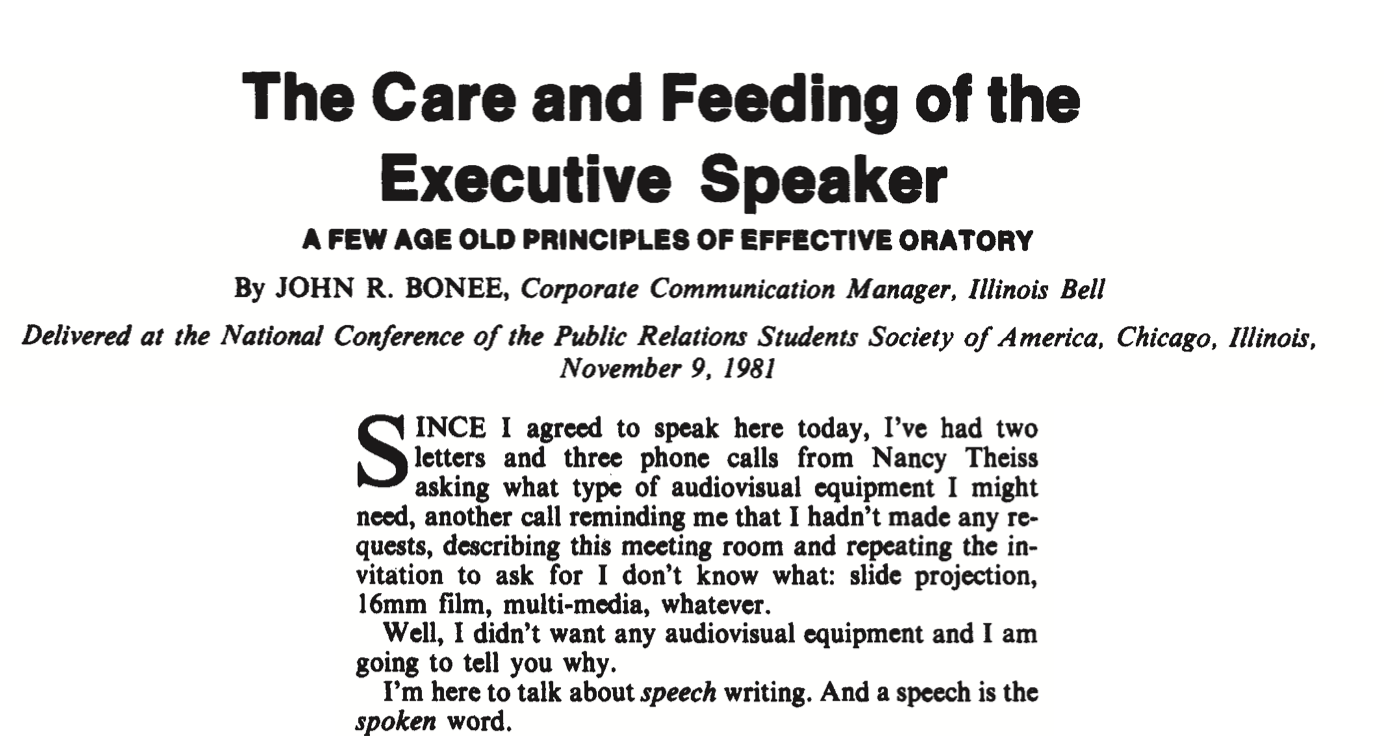Another New Study Advances Another Old Canard About Public Speaking!
March 21, 2024
"Scientists Pinpoint Exact Moment People Lose Their Interest in a Presentation." Why is public speaking so susceptible to such balderdash?
Of all the professions where you might expect to find a shadowy gang of shysters, pettifoggers and liar’s-poker sharpers—think horse-trading and used-car dealing—you wouldn’t think public speaking training would rank near the top. Oh, but it does.
For well over half a century we have been dis-enlightened over and over again by “the latest research” showing that people fear public speaking more than they fear death. It’s the canard that never dies, despite the fact that people keep accepting invitations to speak, but not to walk the plank. And we’ve never heard of a suicide note that said, “Had to give a preso, could not face it.”
More balderdash that keeps on balderdashing: Communication is only seven percent verbal, and 93% non-verbal. This one has a name—it’s called the Mehrabian Myth—and yet it’s still cited by speaking coaches everywhere, to convince waterbrained leaders that it’s not what they say that matters, but how they gesture, when they say it.
And here comes noted CEO communication coach Carmine Gallo*, citing “a recent Finnish study” in an Inc. magazine article headlined: “Scientists Pinpoint the Exact Moment People Lose Their Interest in a Presentation.”
“If the study were based on participants filling out a survey, I wouldn’t cite it here,” Gallo writes. “However, this experiment required people to wear devices that measured their heart rates, and the results were cross-checked with their subjective feedback.” They “reported feeling drowsy (and some nearly fell asleep) after just 10 minutes.”
Writes Gallo:
The study reinforces another experiment that University of Washington biology professor John Medina conducts with his students every year, which reaches the same conclusion.
Medina says, “After 9 minutes and 59 seconds, the audience’s attention is getting ready to plummet to near zero.”
Really!
Regardless of the speaker, regardless of the audience, regardless of the subject, regardless of the moment!
Yes, Gallo implies, regardless of all that. Regardless of everything but a few techniques he recommends, for slapping the audience back awake.
For my own keynote presentations, which are typically slated for 45 minutes, I use video clips from famous speeches or presentations to complement my ideas. The video clips are as short as 30 seconds to a minute, but long enough to create a mental break that keeps the audience tuned in.
I have been around the speechwriting and public-speaking business for more than 30 years (he writes, wearily). At one of the very first speechwriting conferences I attended, a star communications professor named Kathleen Hall Jamieson** told the assembled speechwriters that, to keep their jobs for the television age, they needed to write in soundbites! Because attention spans were shrinking! It was the age of MTV! There was no room anymore for sustained arguments! Speechwriting as we knew it was dead!
Dr. Jamieson did just what the conference organizers paid her to do. She had all the speechwriters in the old hotel ballroom soaking the cushions of their ballroom chairs—people she had drawn to the conference on the promise of telling them something new and alarming and steeped in research. Mostly hogwash, as it turned out. “Soundbites” then, “smart brevity” now.
Lookee, folks: If you have something to say that’s really important to people, they’ll sit there and listen to it for an hour—as they do for Gallo, and as they did for Jamieson. And if you don’t, God help you—now, as in 1950. People were just more polite about it then, and didn’t have smart phones. So they quietly used the last 20 minutes of your talk to entertain their repressed sexual fantasies.
Rhetoric is an ancient art. Elocution is an old word. One human being standing before a community of others is a ritual honored by tens of thousands of years and every kind of society. Yes, there are new elements and wrinkles in this ritual—Zoom presentations, for instance—but in general, this corner of the universe shouldn’t so easily bowled over by every “recent Finnish study.”
In fact, it shouldn’t be bowled over at all.
***
* I know Gallo, who is a nice guy and a well-regarded speaking coach and nobody’s pettifogger, I’m sure. I just wish he would not promote himself by introducing yet more pseudo-science into a business that has enough crackpot theories (most of them, from its customers).
** I was 24 when I saw Dr. Jamieson speak; I remember thinking of her as an older woman, probably nearing her career denouement. Wikipedia tells me she is 77 now, which would have made her 47 then. Kids!
_______________________________________
And Carmine Gallo responds:
David, I applaud you for taking a skeptical view of the information you come across on the topic of public speaking. In my writing, I avoid citing anything I haven’t thoroughly studied. And in most cases, I want to speak to the researchers directly. So thanks for debunking “balderdash” like the Mehrabian Myth. I’m sure you’d add the “Goldfish attention span” theory to the list of nonsense. No, attention spans are NOT shrinking. Our brains don’t evolve that quickly.
This brings us to the 10-minute rule. If I had another 2,000 words, I could have explored John Medina’s theory of how the brain processes information. Medina, a molecular biologist, believes we have an onboard computer in our brains that switches away after about 10 minutes. I like Medina’s approach because he’s humble and acknowledges that he doesn’t know why it is, but we get bored quickly.
If I didn’t make this clear, I will now: This does not imply that a speaker cannot retain the audience’s attention for an hour or more. It simply suggests that we should use classic speechmaking and writing techniques like the tactics you and other experts recommend to re-engage our audiences. And use those tactics often!



